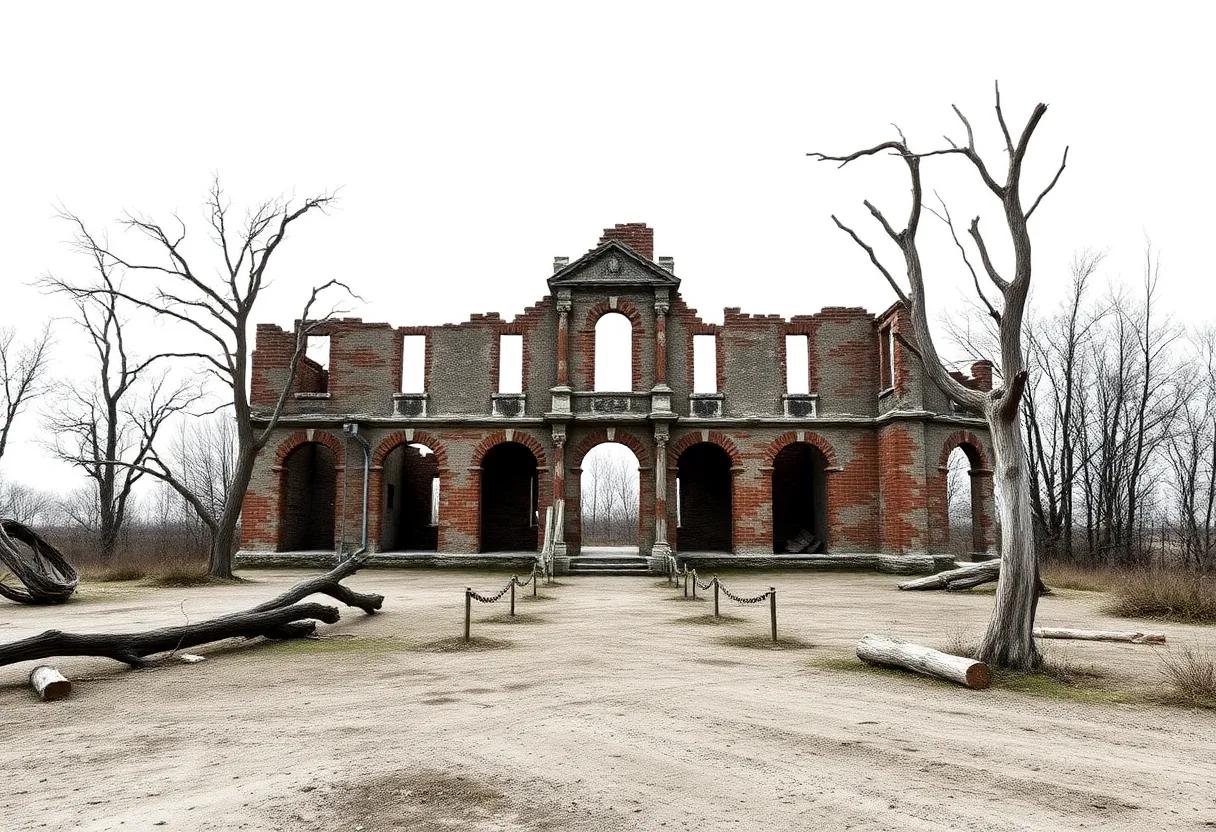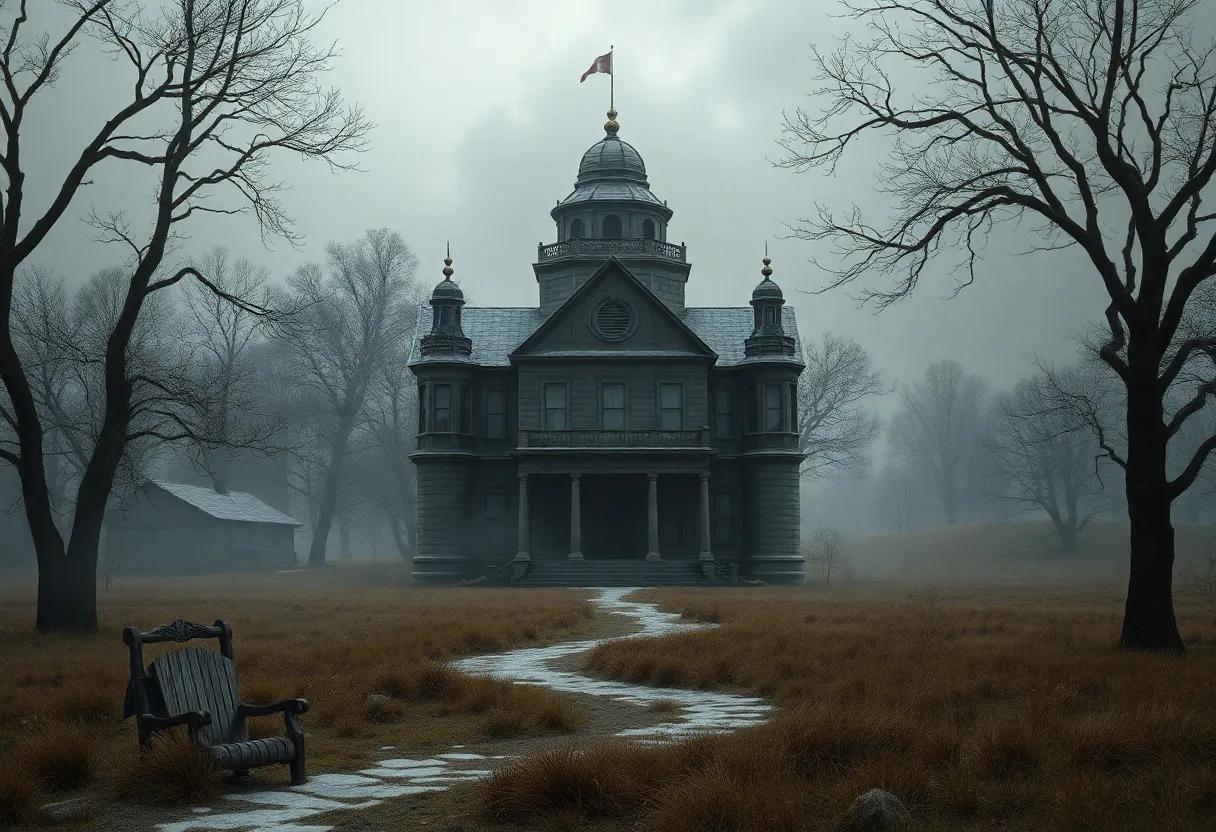william Faulkner’s Absalom, Absalom! stands as a towering monument within the labyrinth of Southern Gothic literature, weaving a dense tapestry of memory, identity, and decay. This novel plunges readers into the tangled roots of the American South, where history and myth collide in haunting reverberations. In exploring Faulkner’s complex narrative and atmospheric prose,this review seeks to unravel the intricate threads that compose the novel’s dark and enigmatic world,illuminating the shadows that define its enduring power and meaning.
Exploring the Intricate Layers of Southern Gothic Atmosphere in Absalom Absalom and Their Impact on the Reader’s Experience

Faulkner masterfully weaves a labyrinthine Southern Gothic atmosphere by embedding layers of decay, memory, and violence within the narrative fabric of Absalom, Absalom! The oppressive heat of the mississippi setting becomes almost tangible, suffusing the story with a sense of relentless pressure and inevitable disintegration. Through the fragmented storytelling and unreliable narrators, the novel becomes a haunting mosaic of the south’s troubled history-its ghosts, deeply rooted in the soil, refuse to remain buried.This layered atmosphere is not merely a backdrop but actively shapes the reader’s immersion, evoking a visceral connection to the region’s complicated legacy of pride, loss, and decay.
readers are invited to navigate through a spectrum of Gothic motifs that enrich this atmospheric complexity, such as:
- Grotesque imagery: decaying mansions and distorted family histories symbolize moral and social collapse.
- Psychological torment: Characters wrestle with obsession and denial,blurring the line between reality and delusion.
- Time as a haunting force: Nonlinear narrative layers past and present,emphasizing history’s inescapable grasp.
The effects on the reader are multifaceted-confusion mirrors the narrative’s fractured construction,heightening engagement as one pieces together the story’s elusive truth. This disorientation, juxtaposed with moments of startling clarity, forces a deep reflection on the consequences of history and memory. The following table highlights how these elements combine to produce an unforgettable Gothic experience:
| Atmospheric Element | Effect on Reader | Narrative Function |
|---|---|---|
| Decay and Ruin | Elicits unease and inevitability | Symbolizes the fall of Southern aristocracy |
| Unreliable narrators | Creates ambiguity and active interpretation | challenges objective truth, mirrors fractured identity |
| Nonlinear Time | Fosters disorientation but deepens understanding | Emphasizes cyclical nature of history |
Dissecting faulkner’s Complex Narrative Structure and Its Role in Unfolding the Southern Past

Faulkner’s narrative technique in Absalom, Absalom! defies linear storytelling, weaving a tapestry of fragmented memories and perspectives that mirror the complexities of the Southern psyche. His method unfolds through a web of unreliable narrators, each filtering the past through personal bias, creating a layered understanding rather than a single truth. This kaleidoscopic approach unsettles customary chronology, allowing the reader to piece together the haunting legacy of the Sutpen family like an archaeological dig of both time and consciousness.The story’s structure becomes a vehicle to explore themes of identity, history, and the persistent ghosts of slavery.
Key elements of Faulkner’s narrative design include:
- Multiple viewpoints: Narrators shift mid-narrative, offering contrasting accounts.
- Non-linear timeline: Events jump back and forth across decades.
- Embedded stories: Tales within tales deepen the mythos around Sutpen’s rise and fall.
- Symbolic repetition: Recurring motifs like the decaying mansion echo fractured memory and Southern decay.
| Technique | Function | Effect on Reader |
|---|---|---|
| Fragmented Chronology | Distorts time, reflects memory | Engages active interpretation |
| Unreliable Narrators | Highlights bias and subjectivity | Creates narrative ambiguity |
| Recursive Storytelling | Deepens thematic resonance | Encourages thematic connections |
The Symbolism of Decay and Ruin as Central Themes Reflecting the South’s Troubled History

Decay and ruin in Absalom, Absalom! serve as haunting metaphors for the South’s attempt to come to terms with its own fractured legacy. Faulkner masterfully embeds the dilapidated Sutpen estate as a symbol of grandeur long extinguished, mirroring the collapse of old Southern ideals that were built on a foundation of slavery, racism, and pride. The rotting mansion is not just a physical structure in decline but also an emblem of the moral and social disintegration that has left the region fragmented and haunted by its past. This pervasive sense of deterioration underscores the weight of history that characters like Thomas Sutpen and Quentin Compson carry with them-ghosts trapped in time, unable to escape the consequences of ancestral sins.
- Ruins mirror the shattered dreams and broken promises of the Old South.
- Decay reflects the inevitable erosion of outdated values resisting change.
- Desolation embodies both physical and emotional landscapes scarred by conflict.
Below is a comparison of symbolic elements associated with decay and ruin in Faulkner’s narrative, highlighting their layered meanings within the Southern Gothic tradition:
| Symbol | Physical Aspect | Symbolic Meaning |
|---|---|---|
| sutpen’s Mansion | Crumbling walls & overgrown grounds | Collapse of ambition and legacy |
| Fallen trees & Dead branches | Desolate, lifeless surroundings | Stunted growth and decay of family lineage |
| Abandoned artifacts | Dust-covered heirlooms & broken furniture | lost heritage and forgotten truths |
Character Portraits in Absalom Absalom Highlighting Morality, Identity, and Family Legacy Conflicts

In the labyrinthine world of Absalom, Absalom!, characters are not merely players in a narrative but emblematic vessels through which Faulkner probes deep questions of morality, identity, and the turbulent legacy of family. Thomas Sutpen, the architectural force of devastation, embodies the destructive pursuit of legacy, driven by a vision that eclipses human empathy. His stubborn ambition fractures not only his bloodline but also the moral fabric surrounding him, illustrating how an obsessive desire for status and permanence in the Old South inevitably breeds ruin. Meanwhile, characters like Judith and Quentin carry the heavy burden of identity anxiety; their conflicting loyalties to family and self mirror the broader Southern struggle to reconcile pride with the ghosts of history.
The intricacies of these portraits are best grasped by examining their conflicted attributes side by side:
| Character | Morality | Identity Conflict | legacy Impact |
|---|---|---|---|
| Thomas Sutpen | Calculating, amoral ambition | Self as empire-builder vs. cost to humanity | Destruction & estrangement |
| Judith Sutpen | Protective but judgmental | Familial loyalty vs. personal bitterness | Perpetuation of bitterness |
| Quentin Compson | Haunted, introspective | Family myths vs. reality | Questioning Southern legacy |
This chiaroscuro of human conflict-light intertwined with shadow-pushes readers to question how identity is forged and fractured by the past. Faulkner’s characters wrestle not only with their own ideologies and familial expectations but with an entire cultural mythology that clings to the South’s historical sins. The portrayals underscore how each figure’s internal dilemmas reflect broader societal scars,making their struggles deeply resonant across generations.
- Morality: Characters’ actions challenge traditional notions of right and wrong.
- Identity: Internal conflicts reveal fractured personal and collective identities.
- Family Legacy: The inescapable weight of the past shapes present destinies.
The Use of Myth and Memory to Construct a Multi-Dimensional Southern Gothic Landscape

In Absalom, Absalom!, Faulkner weaves a rich tapestry where myth and memory become essential tools for crafting a Southern Gothic landscape that is as haunting as it is indeed multi-dimensional. The novel’s narrative structure itself resembles an intricate labyrinth, where every retelling and remembered whisper deepens the mythic aura surrounding the Sutpen family saga. Time is fragmented, and history is presented less as objective fact and more as a shadowy interplay of subjective memories, blending folklore with personal trauma. This technique amplifies the eerie atmosphere characteristic of Southern Gothic literature, turning the South into a living, breathing palimpsest-both a place and a manifestation of fractured histories, lingering guilt, and unresolved tensions.
Faulkner’s use of mythic imagery, often rooted in Southern identity, imbues the landscape with symbolic weight. The decaying Sutpen estate, the oppressive heat, and the cyclical nature of the characters’ downfall all serve as motifs where human memory distorts reality like a funhouse mirror. Key elements include:
- Genealogical echoes linking past sins to present consequences
- Oral tradition as a mechanism for both preservation and distortion
- Time collapses that collapse past and present into a single haunted moment
| Mythic Element | Symbolic Function |
|---|---|
| The Sutpen Family | Embodiment of ambition, decay, and the South’s troubled legacy |
| The Haunted Plantation | physical representation of ancestral guilt and hidden secrets |
| War and Ruin | Cycle of destruction echoing through generations |
how Faulkner’s Language style Enhances the Mood and Themes in Absalom Absalom
Faulkner’s prose in Absalom, Absalom! is a labyrinth of intricate sentences, where time folds upon itself and memory intertwines with reality. His distinctive use of stream-of-consciousness narration captures the fractured psyche of the South, echoing its troubled history and tangled familial legacies.The dense, poetic language drips with a haunting melancholy, creating an atmosphere thick with tension and unresolved guilt.This linguistic complexity mirrors the novel’s themes of decay and the elusive nature of truth, compelling readers to piece together the puzzle alongside the characters. Every convoluted phrase, every shadowy description, invites a deeper immersion into the Southern Gothic’s eerie mood and moral ambiguity.
Through his stylistic choices, Faulkner also invokes a sense of inescapable fate and tragic grandeur. The repetition of motifs such as bloodlines, shadows, and silence intensifies the novel’s examination of legacy and identity. Consider the following stylistic elements that shape the reading experience:
- Nonlinear narrative structure: disrupts temporal flow, emphasizing the fragmented nature of memory.
- Dense imagery: conjures vivid, frequently enough unsettling visuals that evoke the oppressive weight of history.
- Multilayered perspectives: reveal subjective truths, underscoring how reality is filtered through personal biases.
| Language Feature | Effect on Mood | Thematic Contribution |
|---|---|---|
| Complex syntax | Creates tension and unease | Reflects fragmented truth and history |
| Symbolic imagery | Dark, gothic atmosphere | unveils decay and destiny |
| Multiple viewpoints | Layered, haunting ambiguity | Explores subjectivity of narrative |
Unveiling the Social Critique Embedded in Faulkner’s Portrayal of Race and Power Dynamics
Faulkner’s intricate narrative layers lay bare the enduring scars of race and power that haunt the South, transforming Absalom, Absalom! into more than a family saga-it becomes a labyrinth of cultural and societal critique. Through the tragic rise and fall of Thomas Sutpen, Faulkner exposes the insidious foundations of white supremacy tied to land, lineage, and legacy. Sutpen’s relentless quest for dominance elucidates how power is both constructed and corrupted by racial hierarchies, where identity is inextricably bound to ownership and control. His story unravels the moral decay embedded in a system predicated on exclusion and violence, revealing a South obsessed with preserving its fractured past at a devastating cost.
Key motifs that underscore this social commentary include:
- Blood and heritage: the obsession with purity and lineage as markers of power and social standing.
- Silence and narrative gaps: the stories never told or selectively remembered, hinting at uncomfortable truths about race relations.
- The haunted landscape: the physical South mirrors the psychological and moral shadows cast by slavery and oppression.
| Element | Social Implication | Faulkner’s Viewpoint |
|---|---|---|
| Thomas sutpen’s Myth | Foundation of a racially segregated society | Cautionary tale of power corrupted by ambition |
| Sutpen’s Daughter | Intersection of race and forbidden desire | Critique of rigid social boundaries |
| Plantation as Symbol | Legacy of slavery and domination | Physical manifestation of historical trauma |
The Role of Silence and Unspoken Truths in Shaping the Novel’s dark and Haunting Tone
In Absalom, Absalom!, William Faulkner masterfully employs silence as a powerful narrative device that amplifies the novel’s unsettling atmosphere. The characters’ frequent retreats into unspoken thoughts and half-revealed memories create a profound sense of mystery and dread. This intentional withholding of details forces readers to navigate a labyrinth of fragmented stories and shadows, mimicking the way trauma and history can linger unvoiced within families and communities. Silence here is not emptiness but a charged space,heavy with the weight of secrets that twist perceptions and deepen the novel’s melancholic aura.
These unspoken truths manifest through:
- Ambiguous testimonies: Characters often contradict themselves or evade full disclosure, leaving the truth tantalizingly out of reach.
- Symbolic silences: Pauses and gaps in dialog serve as echoes of unresolved tensions and buried guilt.
- Atmospheric tension: The quite moments between revelations build an oppressive mood that haunts the narrative landscape.
This intricate interplay of what is said and left unsaid not only shapes the novel’s dark tone but also reflects the fractured legacy of the Southern past-where silence conceals as much as it reveals.
| Element | Effect on Tone |
|---|---|
| Ambiguous Narration | Creates uncertainty and suspense |
| Selective Memory | Highlights unreliable perspectives |
| Unspoken Familial Traumas | Generates emotional weight and sorrow |
| Lingering Pauses | Builds an eerie, haunt-like atmosphere |
Recommending Absalom Absalom for Readers Interested in Complex Narratives and Historical reflection
For readers who relish narratives layered with intricate emotions and fragmented storytelling, Faulkner’s masterpiece offers a labyrinthine journey through the heart of the American South. This novel doesn’t simply recount a story-it demands active engagement,piecing together memories,perspectives,and histories that blur the lines between fact and myth. Individuals who appreciate literature that challenges conventional storytelling will find themselves immersed in a world where every sentence is charged with deeper meaning and every character bristles with unresolved tensions from a troubled past.
Key reasons to delve into this work include:
- Exploration of memory and subjective truth
- Rich depiction of Southern culture and heritage
- Complex character dynamics woven into historical tragedy
- innovative narrative structure that rewards attentive reading
| Aspect | Why It Matters |
|---|---|
| Narrative Structure | Challenges readers to assemble the timeline and truths |
| Historical Context | Offers a haunting reflection on the legacy of the South |
| Symbolism | Rich, layered imagery enhancing thematic depth |
Tips for approaching the Novel to Fully Appreciate Its Narrative Depth and Symbolic richness
To truly immerse yourself in Faulkner’s intricate world, begin by embracing the novel’s nonlinear narrative structure. Allow yourself to navigate the fragmented timelines and multiple perspectives without rushing to piece together a traditional plot. Pay close attention to the distinct voices and biases shaping each account, as they layer meaning and deepen character complexity. Annotating passages or mapping relationships between characters can be invaluable tools for tracing recurring motifs and the elusive truths buried within family secrets. Remember, the novel’s richness lies not only in what is said but in what remains ambiguous or unsaid, inviting readers to engage actively with its narrative puzzles.
Symbolism permeates every corner of this Southern Gothic masterpiece, reflecting themes of decay, ambition, and the haunted legacy of the American South. to unearth these layers, focus on symbols such as the Sutpen estate, the pervasive imagery of ghosts, and recurring references to the natural world. Consider using the following guide as a quick reference to decode the symbolism:
| Symbol | Meaning | Associated Themes |
|---|---|---|
| The Sutpen Estate | Decay of ambition and legacy | Power, downfall, pride |
| Ghosts and Shadows | Haunting past and guilt | Memory, loss, identity |
| The River | Flow of time and change | History, transition, renewal |
| Fire | Destruction and cleansing | Violence, transformation |
- Delve into the historical context surrounding the post-Civil War South to better grasp the social tensions threading through the narrative.
- Be patient with Faulkner’s prose style, which frequently enough reflects the complexity of the characters’ inner lives and the cultural landscape they inhabit.
- Engage with secondary literature or discussions that explore differing interpretations-this can illuminate subtleties that might not be instantly apparent on a first read.
Connecting Faulkner’s Southern Gothic Masterpiece to Broader Literary Traditions and Influences
Faulkner’s Absalom, Absalom! is deeply entrenched in the Southern Gothic tradition, yet it also converses with broader literary movements that enrich its narrative complexity. This novel echoes the Modernist emphasis on fragmented storytelling and unreliable narration, techniques used to reflect the fragmented human psyche and the elusiveness of truth. Faulkner blends gothic elements such as decaying plantations, haunting family secrets, and enigmatic characters with a Modernist experimentation of time and perspective, creating a tapestry that transcends simple genre boundaries. These intersections reveal how faulkner not only critiques the South’s troubled history but also participates in a global reevaluation of identity and memory prevalent in 20th-century literature.
Additionally, Faulkner’s work resonates with themes from classical tragedy and the Southern oral tradition, weaving them into his narrative fabric. The characters operate within a fate-bound world reminiscent of Greek tragedies, where ambition, pride, and downfall are inexorably linked. Simultaneously occurring, the multilayered storytelling mimics the dialectic and cadence of Southern folklore, infusing the text with a unique regional authenticity. Consider the following elements that bridge Faulkner’s work to wider traditions:
- Modernist narrative innovation: non-linear timelines and psychological depth
- Classical tragedy motifs: hubris, fatalism, and moral ambiguity
- Southern oral storytelling: layered narratives and evocative regional dialects
- Gothic symbolism: decay, the supernatural, and haunted landscapes
| Literary Tradition | Influence on Absalom, Absalom! | Key Characteristics |
|---|---|---|
| Modernism | Fragmented narrative, unreliable narrators | Dislocation, stream-of-consciousness |
| Classical Tragedy | Character flaws driving downfall | Hubris, fate, catharsis |
| Southern Gothic | Decay, grotesque figures, decayed settings | Darkness, mystery, social critique |
| Oral Tradition | storytelling framework and regional voice | Repetition, cadence, folklore |
Analyzing the Impact of Setting and Landscape as Characters in Their Own Right
In Absalom, Absalom!, the Southern landscape transcends its traditional role, evolving into a living, breathing entity that shapes every narrative turn and character decision. Faulkner’s Mississippi isn’t merely a backdrop; it is indeed infused with memory, decay, and the weight of history, embodying both beauty and brutal oppression. The sprawling plantations, the dense woods, and the oppressive humidity become symbolic extensions of the characters’ internal struggles, reflecting themes of familial legacy, racial tension, and the inescapable grip of the past. This pulsing environment demands recognition as a character itself, one whose moods and textures dictate the rhythm of the story much like Sutpen’s own inscrutable will.
Consider the elements that animate this setting:
- Decay and Ruin: The crumbling estates mirror the disintegration of Southern ideals, haunting the characters with both grandeur and loss.
- Wildness and Entrapment: The impenetrable forests and rivers act as both sanctuary and cage, shaping destinies through their physical and metaphorical boundaries.
- Time and Memory: The landscape holds a collective memory, a palimpsest upon which the past is constantly rewritten and relived.
| Landscape Aspect | Symbolic Meaning | Impact on Plot |
|---|---|---|
| Shady Oaks Plantation | Legacy & Decline | Site of Sutpen’s rise and fall, reflects grandeur tainted by brutality |
| Dense Forests | Obscurity & Secrets | Hide dark truths, provide setting for pivotal confrontations |
| Mississippi River | Flow of Time & Change | Represents unstoppable historical forces shaping fate |
Faulkner’s artistry lies in his capacity to imbue these physical elements with emotional and psychological gravitas.The Southern landscape serves as a silent narrator, mediating between characters’ perspectives and the reader’s understanding.Its presence is felt in every whispered rumor, every moment of hesitation, and every burst of violence.Thus, these settings act not just as scenery, but as catalysts for transformation-at once a witness, a prisoner, and a manipulator of ancestral sins unfolding across generations.
The Enduring Legacy of William Faulkner and His Influence on American Literature Through Absalom Absalom
William Faulkner’s mastery in Absalom, Absalom! presents an unparalleled exploration of the Southern Gothic tradition, weaving a complex narrative that dissects themes of identity, memory, and the haunting specters of history. His nonlinear storytelling and dense prose create a labyrinthine structure that challenges readers, reflecting the fractured legacy of the American South itself. Faulkner’s work compels us to confront the difficult truths beneath the surface – where family secrets, racial tensions, and the southern aristocracy’s decay converge in a gripping tapestry of human frailty and pride.
Through this novel, Faulkner has profoundly influenced American literature, inspiring generations of writers to push boundaries in narrative form and thematic depth. his intricate character studies and bold experimentation with time and perspective have become hallmarks of literary innovation. Below are key elements of Faulkner’s enduring influence:
- Fragmented Narrative: Encouraging a departure from straightforward storytelling to evoke complexity and ambiguity.
- Psychological Depth: Illuminating the inner turmoil of characters entangled in societal and personal conflicts.
- Southern Gothic Motifs: Cementing the genre’s place in American literature through dark, atmospheric settings and moral decay.
| Aspect | Faulkner’s Approach | impact on Literature |
|---|---|---|
| Time | Nonlinear and layered chronology | Inspired experimental narrative techniques |
| Voice | Multiple narrators with unreliable perspectives | Challenged the authority of a single narrative viewpoint |
| Theme | Focus on legacy, race, and identity | Expanded literary discourse on American cultural history |
In traversing the tangled corridors of Absalom, Absalom!, we encounter not just the echoes of a fractured South but the intricate loom upon which Faulkner weaves his Southern Gothic tapestry. This novel resists simple interpretation, beckoning readers to untangle its shifting narratives and confront the haunting legacies entwined within. whether viewed as a profound meditation on history and identity or as a cryptic literary puzzle, Faulkner’s masterpiece remains an enduring testament to the complexity of storytelling itself-inviting each new reader to piece together its shadowed mysteries anew.










